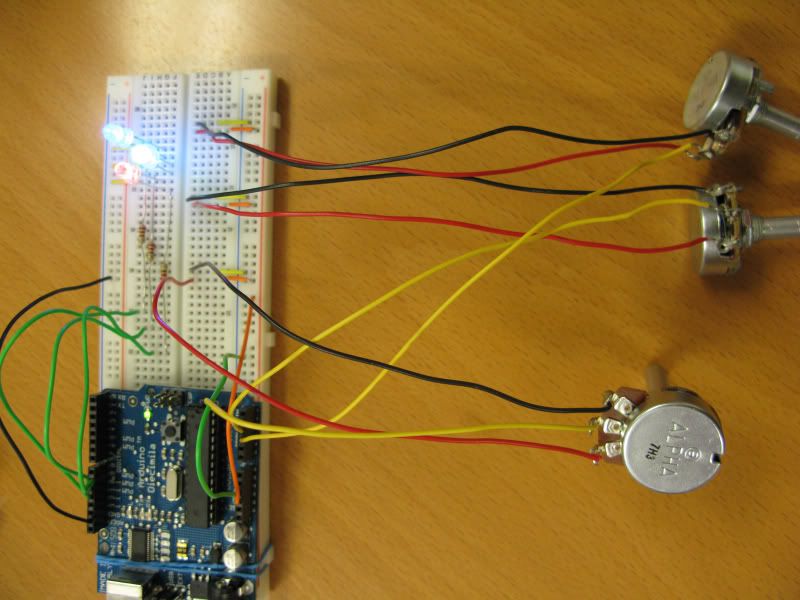Assignment: Sensing: Potentiometers
Collaborators:

<!--[if gte mso 10]>
Description:
A project that uses the Arduino board and programming environment to demonstrate how to make three separate LEDs light up according to a programmable interval.
Components List:
Notes:
I used the three hands to control the pots.
Acknowledgments:
The potentiometers were tangled but working. I’d like to arrange them better next time.
Code used in this Assignment:
/*
* "Coffee-cup" Color Mixer:
* Code for mixing and reporting PWM-mediated color
* Assumes Arduino 0004 or higher, as it uses Serial.begin()-style communication
*
* Control 3 LEDs with 3 potentiometers
* If the LEDs are different colors, and are directed at diffusing surface (stuck in a
* a Ping-Pong ball, or placed in a paper coffee cup with a cut-out bottom and
* a white plastic lid), the colors will mix together.
*
* When you mix a color you like, stop adjusting the pots.
* The mix values that create that color will be reported via serial out.
*
* Standard colors for light mixing are Red, Green, and Blue, though you can mix
* with any three colors; Red + Blue + White would let you mix shades of red,
* blue, and purple (though no yellow, orange, green, or blue-green.)
*
* Put 220 Ohm resistors in line with pots, to prevent circuit from
* grounding out when the pots are at zero
*/
// Analog pin settings
int aIn = 4; // Potentiometers connected to analog pins 0, 1, and 2
int bIn = 3; // (Connect power to 5V and ground to analog ground)
int cIn = 2;
// Digital pin settings
int aOut = 9; // LEDs connected to digital pins 9, 10 and 11
int bOut = 10; // (Connect cathodes to digital ground)
int cOut = 11;
// Values
int aVal = 0; // Variables to store the input from the potentiometers
int bVal = 0; int cVal = 0;
// Variables for comparing values between loops
int i = 0; // Loop counter
int wait = (1000); // Delay between most recent pot adjustment and output
int checkSum = 0; // Aggregate pot values
int prevCheckSum = 0;
int sens = 3; // Sensitivity theshold, to prevent small changes in
// pot values from triggering false reporting
// FLAGS
int PRINT = 1; // Set to 1 to output values
int DEBUG = 1; // Set to 1 to turn on debugging output
void setup()
{
pinMode(aOut, OUTPUT); // sets the digital pins as output
pinMode(bOut, OUTPUT); pinMode(cOut, OUTPUT);
Serial.begin(9600); // Open serial communication for reporting
}
void loop()
{
i += 1; // Count loop
aVal = analogRead(aIn) / 4; // read input pins, convert to 0-255 scale
bVal = analogRead(bIn) / 4;
cVal = analogRead(cIn) / 4;
analogWrite(aOut, aVal); // Send new values to LEDs
analogWrite(bOut, bVal);
analogWrite(cOut, cVal);
if (i % wait == 0) // If enough time has passed...
{ checkSum = aVal+bVal+cVal; // ...add up the 3 values.
if ( abs(checkSum - prevCheckSum) > sens ) // If old and new values differ
// above sensitivity threshold
{
if (PRINT) // ...and if the PRINT flag is set...
{
Serial.print("A: "); // ...then print the values.
Serial.print(aVal); Serial.print("\t");
Serial.print("B: "); Serial.print(bVal);
Serial.print("\t");
Serial.print("C: "); Serial.println(cVal);
PRINT = 0;
}
} else
{
PRINT = 1; // Re-set the flag }
prevCheckSum = checkSum; // Update the values
if (DEBUG) // If we want debugging output as well...
{
Serial.print(checkSum);
Serial.print("<=>");
Serial.print(prevCheckSum);
Serial.print("\tPrint: ");
Serial.println(PRINT);
}
}
}